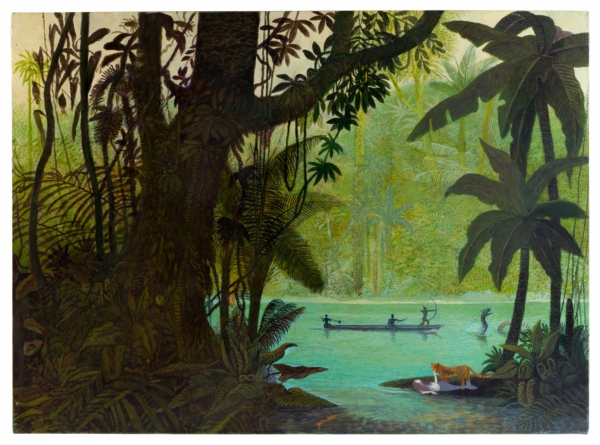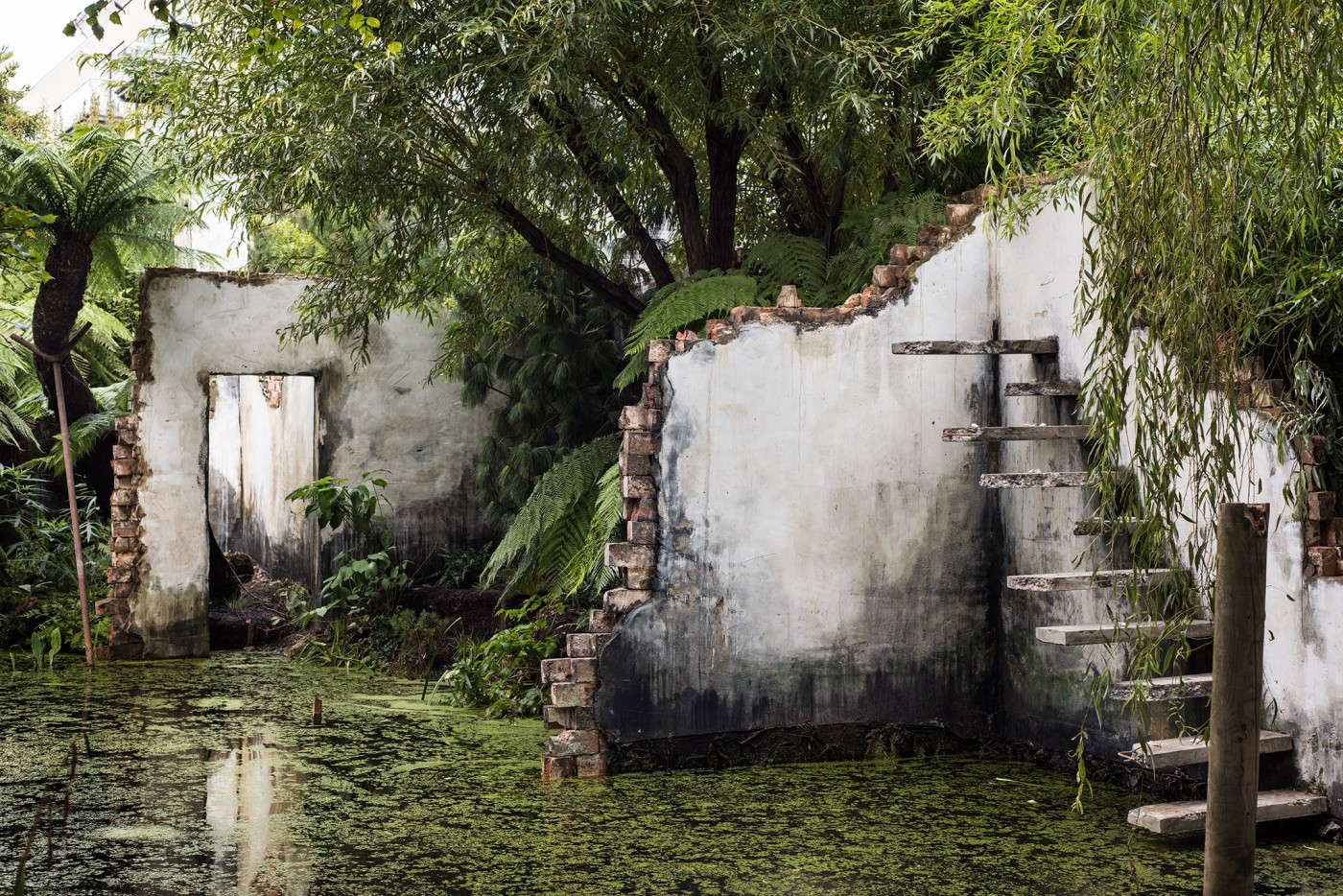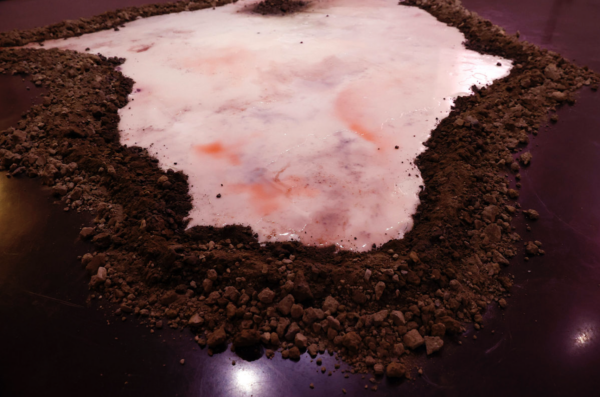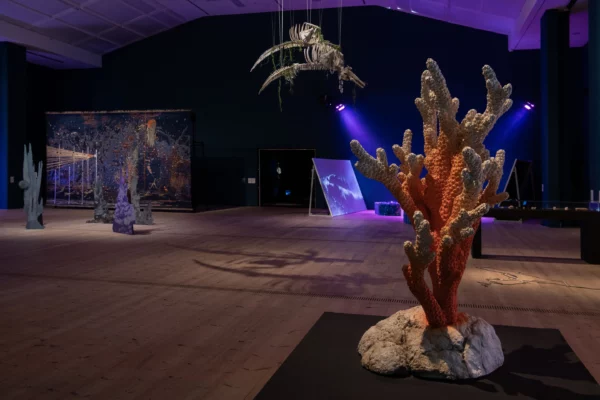
The Earth, the Fire, the Water, and the Winds – CARA
le Center for Art, Research and Alliances (CARA) à New York présente The Earth, the Fire, the Water, and the…

Crédit image : A Gentle Collapsing II, 2016, Timber, render, bricks, steel, paint, 1800 x 900 x 430 cm, 708 5/8 x 354 3/8 x 169 1/4 in
An exhibition of new work by the British artist, including a major architectural intervention in the gallery’s waterside garden.
Thoughts of modernism and its legacy, as well as Romantic ideas of the ruin and the picturesque are conjured in these new works. While modernist architecture has been a constant touchstone for Hartley, amplified in recent work is a sense of narrative, of the viewer having arrived at a situation of ambiguous cause and uncertain outcome.
Resembling an International Style domestic building apparently abandoned to the elements, the major architectural intervention A Gentle Collapsing II transforms the gallery’s waterside garden into a scene of poetic dereliction and decay. Built on the canal bank and into the water itself, the work encapsulates classic modernist tropes – the clean lines and horizontality of Bauhaus architecture as exported to the US by Mies van der Rohe in the 1930s and later exemplified by Philip Johnson and Richard Neutra, amongst others. Yet the structure and what it appears to portray – a home vacated without explanation, open to the elements, its white rendered walls peppered with black mould rising from the waterline – stands in stark contrast to images of domestic architecture and attendant aspirational lifestyles from the period. Instead, created especially for the garden, with its tree ferns suggestive of an ancient subtropical or temperate landscape, A Gentle Collapsing II looks to have undergone an accelerated process of ageing. It is as if we have been teleported into the future in order to look back at the present or very recent past.
The work offers poignant reflection on themes of entropy and decay. It is, in some ways, emblematic of a wider collapsing – of ideals or even spirit. Running contrary to such thoughts, however, is the undeniable aesthetic pleasure we find in ruins – their compelling, transportative quality. In this sense, A Gentle Collapsing II becomes a kind of time machine that frees the mind to wander, gently collapsing or dislocating a sense of linear time as it does so. The work chimes with the idea of the folly as a faux historical structure placed in the landscape to act as a conversation piece, with the real-life ruins that seduced aristocratic tourists on the Grand Tour in the eighteenth century, and with the tastefully timeworn abbeys and classical temples seen in works by JMW Turner, Francis Towne, John Sell Cotman and others.
A further collapsing occurs between genres. Hartley’s work always encourages us to consider how we experience and think about our constructed surroundings – through surface and line, scale and materials, locations and contexts. A Gentle Collapsing II breaks down rigid categories of production, referring as much to painting as to architecture, landscape design, sculpture or even theatre. Similarly, in a new series of wall-based works in which photographic, painterly and sculptural elements are brought together, the idea of the boundary – between interior and exterior, private and public space, manmade and natural environments, two and three dimensions, object and image – is subject to constant re-evaluation. Classic examples of modernist domestic architecture, photographed by Hartley in Los Angeles, form the basis of a series of monochrome wall-based works in which the photographic image and hand-painted elements – describing and embellishing the verdant West Coast landscape – are separated by a layer of semi-transparent Perspex. Caught up in these works are ideas of privacy and voyeurism, and the contradiction of modernist aspiration as epitomised by the glass-walled pavilion giving rise to the desire for boundaries of other kinds.
Comprising sculptural and photographic elements in which the supports of plinth and frame are merged, further large-scale works present fragmentary architectural details in front of dense jungle scenery. As with A Gentle Collapsing II, these works allude to the manmade world versus the natural environment. Narratives of entropy and decay are ever present. Yet, for Hartley, this is a surprisingly fertile territory, one that allows the imagination to roam freely, to envision what might have been and what might be to come.
Biography
Born in 1963, Alex Hartley lives and works in London and Devon. He has recently participated in Folkestone Triennial 2014 and undertaken a residency with the National Trust for Scotland (2013); he has exhibited at venues including the Contemporary Arts Centre, Ohio, US (2014); Louisiana Museum of Modern Art, and Denmark (2013); Manchester Art Gallery, Manchester (2012). In the summer of 2012, a large-scale island originating from the Svalbard Arctic region was brought by the artist on a journey around the south west region of England as a visiting ‘island nation’, with citizenship open to all: At the end of Nowhereisland’s journey, in September 2012, the island was broken up and distributed amongst the 23,003 people from 135 countries who had signed up as « citizens of Nowhereisland ». As a final gesture, a small piece of the island was sent to the edge of space where some particles of rock from the island will remain forever in the upper-stratosphere. A book marking the completion of the Nowhereisland project will be launched during Hartley’s exhibition at Victoria Miro in November 2016. In spring 2017, Hartley, working alongside British artist Tom James, will commence a major public commission in the historic grounds of Compton Verney Art Gallery and Park, Warwickshire.
Informations:
Alex Hartley, After You Left
Exhibition on view: 19 November – 16 December 2016
Victoria Miro Gallery
16 Wharf Road
London N1 7RW
t: 44 (0)20 7336 8109
info(at)victoria-miro.com
More infos on: www.victoria-miro.com
le Center for Art, Research and Alliances (CARA) à New York présente The Earth, the Fire, the Water, and the…
élébrant dix ans d’une collaboration fructueuse avec le Musée de la Chasse et de la Nature, COAL, acteur pionnier et…
L’exposition For All At Last Return, au Baltic Centre for Contemporary Art, réunit un ensemble majeur d’artistes internationaux autour d’une…

